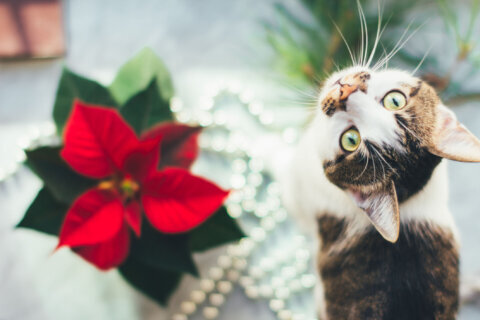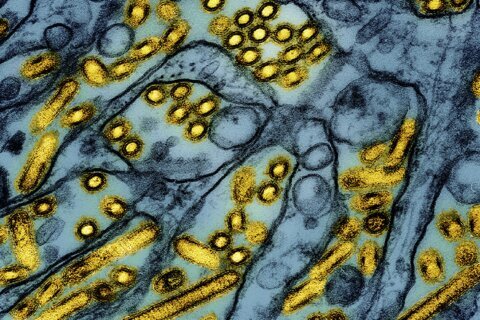UBERABA, Brazil (AP) — Brazil has hundreds of millions of cows, but one in particular is extraordinary. Her massive, snow-white body is watched over by security cameras and an armed guard.
Worth $4 million, Viatina-19 FIV Mara Movéis is the most expensive cow ever sold at auction, according to Guinness World Records. That’s three times more than the last recordholder’s price. And — at 1,100 kilograms (more than 2,400 pounds) — she’s twice as heavy as an average adult of her breed.
Along a highway through Brazil’s heartland, Viatina-19’s owners have put up two billboards praising her grandeur and beckoning people to make pilgrimages to see the supercow.
Climate scientists agree that people need to consume less beef, the largest agricultural source of greenhouse gasses and a driver of Amazon deforestation. But the cattle industry is a major source of Brazilian economic development and the government is striving to conquer new export markets. The world’s top beef exporter wants everyone, everywhere to eat its beef.
The embodiment of Brazil’s cattle ambitions is Viatina-19, the product of years of efforts to raise meatier cows. Prizewinners are sold at high-stakes auctions — so high that wealthy ranchers share ownership. They extract the eggs and semen from champion animals, create embryos and implant them in surrogate cows that they hope will produce the next magnificent specimens.
“We’re not slaughtering elite cattle. We’re breeding them. And at the end of the line, going to feed the whole world,” one of her owners, Ney Pereira, said after arriving by helicopter to his farm in Minas Gerais state. “I think Viatina will provide that.”
The cow’s eye-popping price stems from how quickly she put on vast amounts of muscle, from her fertility and — crucially — how often she has passed those characteristics to her offspring, said Lorrany Martins, a veterinarian who is Pereira’s daughter and right hand. Breeders also value posture, hoof solidity, docility, maternal ability and beauty. Those eager to level up their livestock’s genetics pay around $250,000 for an opportunity to collect Viatina-19’s egg cells.
“She is the closest to perfection that has been attained so far,” Martins said. “She’s a complete cow, has all the characteristics that all the proprietors are looking for.”
INDIA TO BRAZIL
In Brazil, 80% of the cows are Zebus, a subspecies originating in India with a distinctive hump and dewlap, or folds of draping neck skin. Viatina-19 belongs to the Nelore breed, which is raised for meat, not milk, and makes up most of Brazil’s stock.
The city of Uberaba, where Viatina-19 lives, holds an annual gathering called ExpoZebu that bills itself as the world’s biggest Zebu fair. Held several weeks ago, it was a far cry from the Brazil that’s imagined abroad. The dress code was boots, baseball caps and blue jeans. Evening concerts drew 10,000 spectators belting out their favorite country songs. But the main attraction was the daily cattle shows where cows compete for prizes that boost an animal’s auction price.
The most prestigious auction is called Elo de Raça, held April 28. As the first cow entered the paddock, speakers blared Queen’s “We Are the Champions.” But that cow was a mere appetizer before this year’s starlet, Donna, and three of her clones; the final sale price put her total value at 15.5 million reais ($3 million.)
A commodities boom in the 2000s turbocharged Brazilian agriculture, especially with a rising China buying soy and beef. Today, agriculture’s influence extends to Brazil’s Congress and the national consciousness. And Brazil, along with the U.S., is at the forefront of cattle genetics.
Showstoppers like Donna and Viatina-19 are rarities in Brazil, which has more than 230 million cows, according to the USDA. It’s the world’s largest beef cattle population, and that’s problematic; huge swaths of Amazon rainforest have been slashed to create pasture, releasing carbon stored in trees. And cows belch methane that’s far worse for the climate.
Genetic improvements that reduce cows’ slaughtering age are helpful but limited ways to reduce warming. Simpler, more effective measures include planting better grass for grazing and regularly moving cattle from pasture to pasture, said Beto Veríssimo, an agronomist and the co-founder of an environmental nonprofit called Imazon.
Meanwhile, President Luiz Inácio Lula da Silva has been working to open new markets. Last month, he met Prime Minister Fumio Kishida of Japan, home to the premium, marbled Wagyu beef; he urged his counterpart to taste Brazilian meat and become a believer.
“Please,” he said, addressing his vice president at the event, “take Prime Minister Fumio to eat steak at the best restaurant in Sao Paulo so that, the following week, he starts importing our beef.”
SEND IN THE CLONES
Down the highway from the Elo de Raça auction is the laboratory of the company Geneal Animal Genetics and Biotechnology. In a small pen behind it, a cloned calf recently lay in the sunshine, still too unsure of its newborn legs to stand. Another born by cesarean section 20 minutes earlier pressed backwards against a stall’s rear wall, unsettled by this strange new world. Clones of Viatina-19 are due in a few months, said Geneal’s commercial director, Paulo Cerantola.
Some ranchers wouldn’t want a big herd of her clones. High-maintenance cows like Viatina-19 aren’t profitable on a large, commercial scale because they couldn’t meet their energy needs from grass alone, said P.J. Budler, international business manager for Trans Ova Genetics, an Iowa-based company focused on improving the bovine gene pool.
“For the environment and the resources that it would take to run a cow like (Viatina-19), she fits the mold ideally, but she’s not the answer for all cattle everywhere,” Budler said.
Viatina-19’s owner, Pereira, said she gets special treatment to boost egg cell production, but would thrive were she put to pasture — where almost all his elite cattle feed.
Meanwhile, Viatina-19 is pregnant for the first time, and Pereira’s eyeing expansion; her egg cells have sold to Bolivian buyers and he wants to export to the United Arab Emirates, India and the US.
His veterinarian daughter, Martins, is looking even farther ahead.
“I hope she is the basis for an even better animal in the future, decades from now,” she said.
Copyright © 2024 The Associated Press. All rights reserved. This material may not be published, broadcast, written or redistributed.







